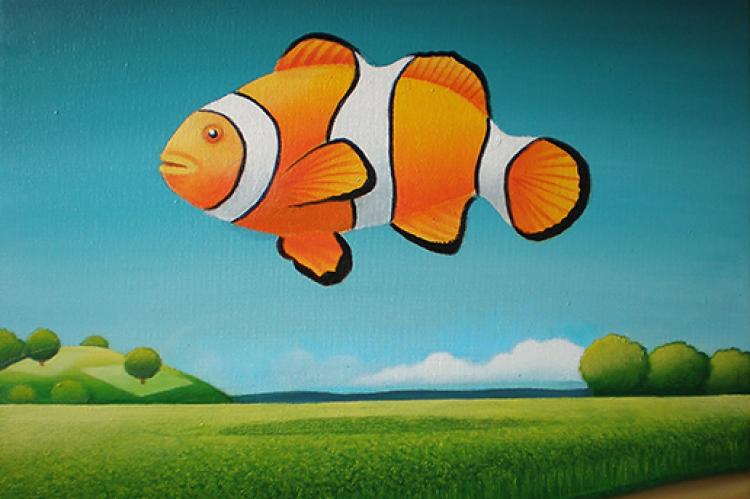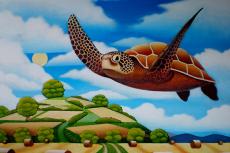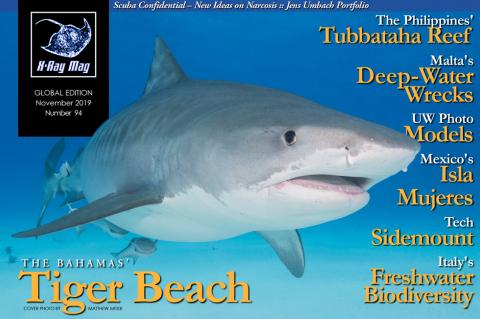Jens Umbach Portfolio
German artist and illustrator Jens Umbach creates surreal paintings of marine life floating in pastoral landscapes and deep-sea creatures in otherworldly seascapes with underwater moons. With a new children’s book soon to be published, X-Ray Mag interviewed the artist to learn more about what inspires his fantastical and imaginative imagery.
"We know more about the dark side of the moon than we know about the depths of the oceans, and so it is a perfect hunting ground for one’s imagination."
—Jens Umbach"
X-RAY MAG: Tell us about yourself, your background, and how you became an artist.
JU: I am a painter and illustrator, living in Germany near the city of Kassel. This is the area where the Brothers Grimm found many of the stories for their fairy tale collection and it really is a nice little corner of the world, very rural with lots of woods all around and all kinds of natural habitats. Growing up in these surroundings, I always had a close and direct connection to nature. I think this is the reason why I mostly paint landscapes and animals.
When I think about it, it is hard to say how I became an artist, because ever since I was a child, I just always kept doing what I loved—drawing and painting. It all became a bit more professional in the 1990s when I started to publish illustrations in magazines, and on book and CD covers. Then, around 2005, I started painting in larger formats with acrylic paint on canvas.
I think that I am influenced by the surrealist painters, especially Max Ernst and René Magritte, but I also love the works of Vincent van Gogh and other impressionists. In my paintings, I try to combine these two different things—the surreal and the natural world.
X-RAY MAG: Why marine life and underwater themes? How did you come to these themes and how did you develop your style of painting?
JU: My fascination with marine life is founded in its overwhelming beauty and diversity. I am especially fascinated by coral reefs and their seemingly endless riches of shapes and colours.
But I am also very interested in the deep sea. This is the place where a surrealistic painter’s dreams (or nightmares?) come true. It is hard to imagine more bizarre and impressive life forms. The deep-sea anglerfish or the vampire squid, for example, are really incredible, and every deep-sea expedition discovers new wonderful and strange creatures. We know more about the dark side of the moon than we know about the depths of the oceans, and so it is a perfect hunting ground for one’s imagination.
I think I developed my style of painting just by practice. You have got your influences from the work of other artists you admire and then you have got so many impressions from everywhere, gathered in your mind over the years. And somehow it all comes together at one point, and maybe, what comes out is one’s own unique style.
X-RAY MAG: What is your artistic method or creative process?
JU: Sometimes I use the “decalcomania” technique to create a picture. In this technique, you cover up the canvas with liquid paint and then it gets pressed against a pane of glass or a board. When you take it off the canvas, the paint leaves a fascinating, natural-looking pattern that often looks like ancient weathered rocks, moss or corals.
Then, you have got to figure out what you see in these structures and make it recognisable for the viewer. In this way, you can create all kinds of landscapes, animals or zoomorphic creatures. This method was often used by Max Ernst.
At other times, I just find an animal that I really like, or that fascinates me in some way, and I let it float over a field of wheat, for example, placing it somewhere it cannot exist in reality. I love to imagine a sea turtle or a manatee taking a little holiday trip out of the water and spending some time floating through the country skies. In this way, I am just combining different things that I like. The place where I live was an ocean in prehistoric times, and sometimes, I wonder how it must have been.
X-RAY MAG: What is your relationship to the underwater world and coral reefs? Are you a scuba diver or snorkeller? If so, how have your experiences underwater influenced your art? In your relationship with reefs and the sea, where have you had your favourite experiences?
JU: No, I am not a diver or snorkeller, but I remember having a snorkelling mask when I was a child, which I used to explore small areas of the ocean floor near the shores of the North Sea, where I spent the holidays with my family. Because I am not a diver, I can only explore the coral reefs at shallow depths. For all other places underwater, I refer to books and documentaries, or articles and images on the Internet.
X-RAY MAG: What are your thoughts on ocean conservation and coral reef management and how does your artwork relate to these issues?
JU: When I am looking at the situation of the oceans and the world as a whole these days, it can be really distressing. Recently, I saw a documentary about some scientists growing corals in their laboratories, trying to save almost dead coral reefs by replacing the bleached and dead corals with the ones grown in their tanks.
I admire those scientists for their work, but somehow, it seems to me a bit like fighting against windmills, because global warming will not stop anytime soon. But I am really no expert, so I hope that I may be wrong with my rather pessimistic view on these things.
X-RAY MAG: What is the message or experience you want viewers of your artwork to have or understand?
JU: I think the greatest achievement for me would be to let the viewer experience a bit of calm and peace, even just for a moment. In this world, which seems to move faster and get crazier every day, this would be the greatest thing for me to give the viewer—a little peace of mind.
A second thing I hope for is that maybe the viewer gets a little bit more aware of ocean life, and natural life in general. It is all a wonder, and we are on the way to destroying it all, if we do not change our behaviour radically.
X-RAY MAG: What are the challenges or benefits of being artists in the world today?
JU: One of the great benefits for the artist today is clearly the Internet. The ability to reach almost everybody in this world with one’s art is something that was completely unimaginable for artists of the past.
But the negative aspect of it is the overwhelming and endless flood of pictures the digital world generates every day. So, it is hard to gain attention for one’s own work in this crowd.
X-RAY MAG: How do people—adults and children—respond to your works?
JU: Up until now, I have never seen children react to my paintings. But it just so happens that I am going to publish a children’s picture book, and I am eager to see if they will like it. It is made in a different, more basic style than my paintings.
One memorable interaction happened during a small exhibition of my paintings at a café. Somebody asked me why all the animals in the pictures were so huge, and I just could not explain it, because I just really did not know.
There is no rational reason for the way I paint—it just turns out this way. Rationality and logic do not seem to have a lot to do with it, I think.
X-RAY MAG: What are your upcoming projects, art courses or events?
JU: As I mentioned before, I am very happy to be publishing a marine life-related children’s book this fall. It is about the adventurous journey of a little dumbo octopus called Grimpy. It has been in the making for some time, but now, it is finally ready for printing. I am really looking forward to it.
I have always wanted to make a picture book for children. So, when I learnt about the dumbo octopus some years ago, it was clear to me that it should be the hero of the story. When I completed the pictures and the story of this book three years ago, I showed it to Tanja, a friend, who has a little publishing agency for art exhibition catalogues and similar publications in Berlin, and she wanted to publish it. Her husband, Lars, helped especially with all the things on the financial side, like setting up a crowdfunding project to raise funds for publishing the book. (See: https://www.startnext.com/grimpy/blog#p.nav).
At the moment, there are no plans for editions in other languages, because there is simply no money for that yet. In this first edition, 500 hardcover books will be printed in German, but I always had in mind to include a text sheet for English-speaking readers. It would be great to reach more people with a translation in English or maybe even other languages. ■
For more information or to purchase artwork and prints, please visit the artist’s website at: kunstnet.de/habakuk or his Facebook page at: facebook.com/Jens-Umbach-Malerei-Painting-563873427105970/
Download the full article ⬇︎













